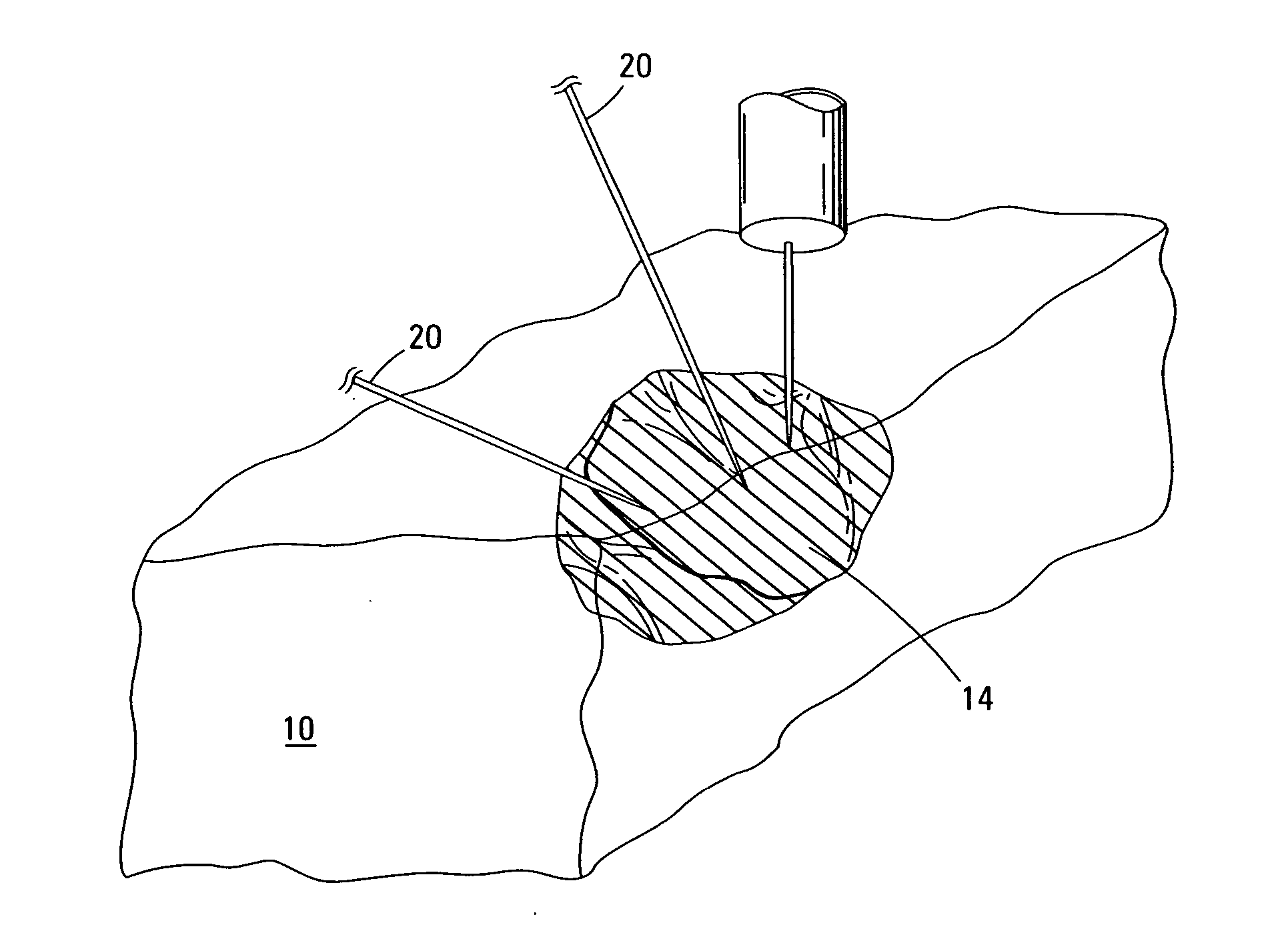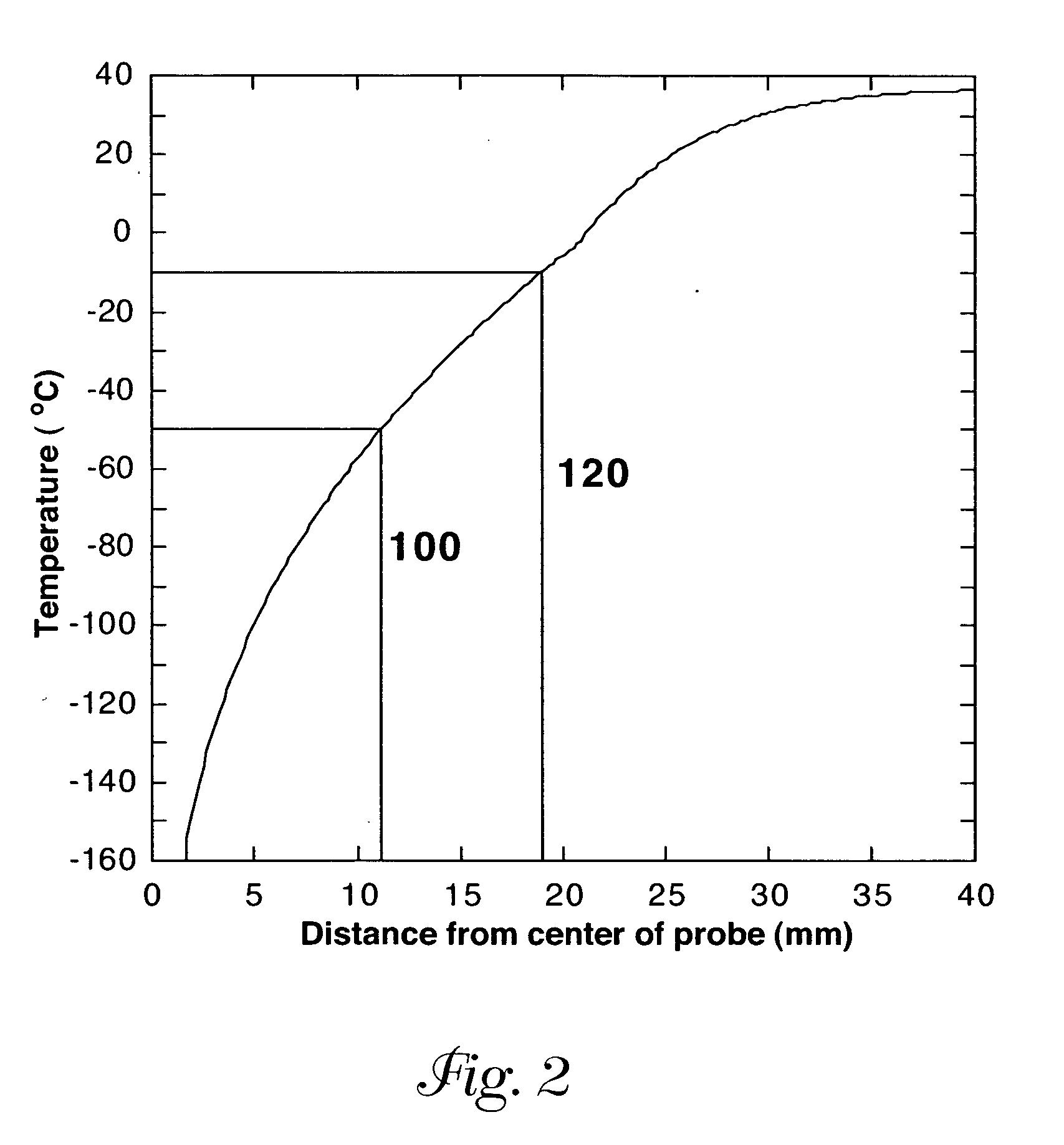Cryosurgery compositions and methods
a composition and cryosurgery technology, applied in the field of cryosurgery, can solve the problems of complex injury effects, cellular water nucleation and intracellular ice formation, and generalized lethal iif, and achieve the effect of facilitating the achievement of eutectic freez
- Summary
- Abstract
- Description
- Claims
- Application Information
AI Technical Summary
Benefits of technology
Problems solved by technology
Method used
Image
Examples
example 1
[0064] AT-1 rat prostate tumor cells were used in the following example. The AT-1 rat prostate tumor cells were cultured in vitro under standard tissue culture conditions, as are known. Cultured AT-1 cells were separated from a culture flask by immersion in 0.05% (by volume) trypsin and 0.53 mM EDTA, and then suspended in 5% (by volume) fetal bovine serum (FBS)-supplemented medium such that the final trypsin concentration was 6 cells / mi. The suspensions were stored in 1.5 ml microcentrifuge tube on ice (about 4° C.).
[0065] To investigate biophysical phenomena during freeze / thaw, a DSC (Pyris 1, Perkin-Elmer Corporation, Norwalk, Conn.) was used. The temperature scale of the DSC was calibrated with two different transition temperatures of cyclohexane (−85.8° C. and 6.4° C.). The heat flow scale of the DSC was calibrated against the heat of fusion of pure water (335 J / g) during thawing at 5° C. / min.
[0066] A directional solidification stage consisting of two constant temperature rese...
example 2
[0072] To induce eutectic formation, potassium nitrate (KNO3), potassium chloride (KCl) and sodium chloride (NaCl) were used in a eutectic changing composition based on their eutectic temperature and concentration as summarized in Table 1, below. The eutectic changing solutions for each of these salts were prepared at a half eutectic concentration (potassium nitrate solution is 5.4% wt. / wt., potassium chloride solution 9.85%, and sodium chloride solution 11.8% wt. / wt.). In freezing experiments with cell suspensions, a half eutectic concentration solution was mixed with cell culture media (Dulbecco's Modified Eagle's Medium / F-12) in 1 (salt solution): 2 (culture media) volume ratio.
[0073] AT-1 rat prostate tumor cells were cultured in vitro under standard tissue culture conditions, as are known. AT-1 cells were suspended in each eutectic changing solution, and kept at about 4° C. Viability changes after mixing in high concentration salt in controls were less than 5% for 2 hours.
TA...
example 3
[0084]FIG. 6 shows DSC thermograms of rat liver tissues either treated with or not treated with a eutectic changing composition of the present invention. The solid line (------) 500 represents data of AT-1 tumor not tissue treated with a eutectic changing composition. The dashed line (- - - - -) 510 represents data of AT-1 tumor tissue treated with a eutectic changing composition of potassium chloride (KCl) at a half eutectic concentration, as described herein. The linked line (--- - --- -) 520 represents data of AT-1 tumor tissue treated with a eutectic changing composition of sodium chloride (NaCl) at a half eutectic concentration, as described herein. The tissues were isolated and underwent freezing 528 and heating 524 (i.e., thawing) as described above.
[0085] The tissue without infusion, line 500, had a heat absorption peak 530 and a heat release peak 534, which were associated with water / ice phase change. However, when the eutectic changing composition of the present invention...
PUM
 Login to View More
Login to View More Abstract
Description
Claims
Application Information
 Login to View More
Login to View More - R&D
- Intellectual Property
- Life Sciences
- Materials
- Tech Scout
- Unparalleled Data Quality
- Higher Quality Content
- 60% Fewer Hallucinations
Browse by: Latest US Patents, China's latest patents, Technical Efficacy Thesaurus, Application Domain, Technology Topic, Popular Technical Reports.
© 2025 PatSnap. All rights reserved.Legal|Privacy policy|Modern Slavery Act Transparency Statement|Sitemap|About US| Contact US: help@patsnap.com



